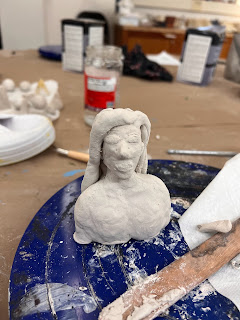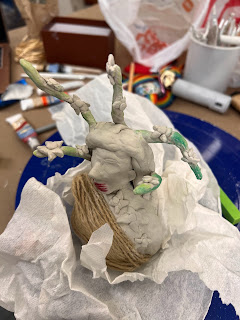Pachamama and Sueños
Air-dry clay, wire, string, wood, acrylic and watercolor paint, and foam
Left sculpture 19" 8" 8" Right sculpture 7" 3" 8"
The sculpture on the left, entitled Pachamama, is commenting on Indigenous people's role in protecting over 80% of the world's biodiversity in an indigenous woman representative of Mother Earth or "Pachamama" looking over a green expanse representing the earth. Indigenous people make up less than 5% of the world's population but still have this profoundly significant role in our natural world. Despite this, Indigenous people have been consistently displaced and discriminated against in an ongoing genocide. Additionally, Native women are murdered 10 times more than any other group and 4 out of 5 Native women experience violence in their lifetime. This has created the MMIWG2S movement, Missing, and Murdered Indigenous Women, Girls, and Two-Spirit. The representation of this movement is a red handprint on the mouth, as shown in the bust. This sculpture represents Indigenous women and people's key place in climate change movements while continuously being harmed and silenced. The black flowers on the base represent the lives that have been taken from the Indigenous community. I made it because of the importance of this injustice when it comes to the topic of climate change as well as social justice.
The sculpture on the right, entitled Sueños, is commenting on the detention of migrant children at the U.S./Mexico border. For a period during Trump's presidency, more than 2,000 migrant children were separated from their parents and kept in detention. And the government lost track of 1,500 migrant children who were placed in the custody of DHHS during this period. This is completely at odds with the idea of the "American dream" that parents specifically buy into when they bring their children here for a better life. The wall in the sculpture shows the Mexican side of the border where the words "Tambien de esta lado hay sueños" translate to "This side has dreams too," in reference to the Dreamer's program. This program has allowed young people to stay in the U.S. with limited rights due to being brought here as young children while criminalizing and offering no path to legalization for their parents. This sculpture is meant to represent that entrapment that is felt when the American dream falls apart on this side of the border with the black bars and upside-down American flag. The irony here lies in seeing this country as the land where dreams come true while so many migrants who come here are discriminated against and rendered invisible. This issue is important to me as the child of migrants, knowing I have the privileges of citizenship and financial stability.
Research:
Due to the criminalization of immigration, over 2,000 children were separated from their parents from April 2018 to June. There were several concerning incidents surrounding the rights of migrant children kept in detention throughout this year which ABA got involved in.
Indigenous groups form a large part of environmental justice movements in stewardship and protection of land and resources, but continue to be pushed aside by big companies and development projects.
Indigenous groups have ensured the conservation of over 30% of the world, more than national parks and forests, but rarely get credit for it due to erasure. There is a common thread of thought which relies on the idea that human interaction is inherently negative when it comes to the natural world which erases all of the work indigenous people have put forward to protect our planet and ignores the role of systems such as capitalism in harming the Earth..
https://www.vox.com/22518592/indigenous-people-conserve-nature-icca
MMIWG is a community movement intended to raise awareness about the lack of attention and action on Native women and girls that dissapear or are killed. Native people are additionally disproportionately killed by police brutality and victims of poverty.
The U.S has lost track of over 1,500 children placed in shelters or foster home under the care of DHHS due to entering the country as unaccompanied minors or due to entering with their parents and being separated. There is no accountability from the system on efforts to locate these children and return them to their families.
In process pictures:
























Comments
Post a Comment